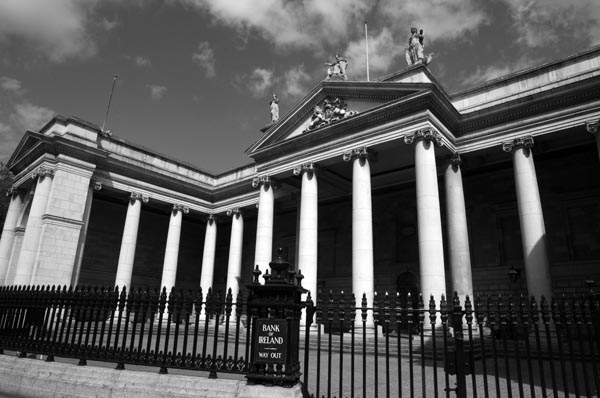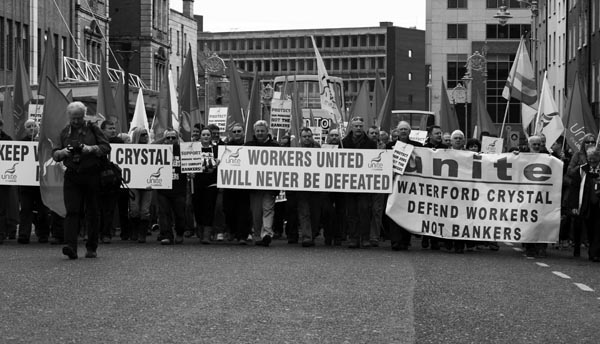With the EU in control, things can only get worse. Ireland’s great need is to revisit the principles of 1916: unfettered control of the country’s destiny in the hands of its people…
Ireland’s boom and bust
WORKERS, JAN 2011 ISSUE
Over the past 20 years, the Irish economy was often hailed as the most dynamic in Europe. Buoyed by membership of the European Union and fuelled by cheap credit and a cheap currency the so-called growth of what became known as the Celtic Tiger was destined to go on and on. Between 1993 and 1998, Ireland’s Gross Domestic Product (GDP) increased by 45 per cent, with annual rates of growth approaching 10 per cent and unemployment falling from 15 per cent to 6 per cent in the same period.

|
| Not so much on the way out as gone: Ireland’s financial independence |
And this was only the beginning. Things got even better, at least on paper, when Ireland joined the euro in 1999. With a new currency being introduced, there was a rush to convert existing holdings of Irish pounds, before they had to be brought to the attention of the tax authorities, into property, creating the boom that lies at the heart of the current problem.
As the boom accelerated, the construction industry raced to build more and more houses without considering properly who was going to buy them and how they were going to pay for them. The number of these new homes peaked at 95,000 in 2006, double the number built in 1997, with the average house now costing 350 per cent more.
It had become a capitalist’s field of dreams; the idea that the only basis needed for making money was money itself, a serpent eating its own tail. The spectacular price rises prompted an orgy of buying.
From 2004 to 2008 the banks simply threw money into building more and more houses that fewer and fewer people could afford to buy. Almost 50 billion euros were advanced in mortgages and even more money was directed towards property developers who were desperate to acquire land anywhere to fund housing estates further and further from any centre of population on the assumption that buyers could be conjured out of thin air.
The price of agricultural land soared as farmers sought to maximise profits by farming land rather than crops, with the price of an acre of unzoned land rising from 5000 to 35,000 euros in a seven-year period. And the madness was not restricted to Ireland. British banks played their usual role in facilitating Ireland’s growing indebtedness; no doubt the reason for George Osborne’s generous offer of assistance to the Irish economy now.
Of course, this situation could not last indefinitely. As Marx puts it, capitalism “sows the seeds of its own destruction”, and the seeds had been carefully fed and watered. A crash was inevitable but for Irish workers the consequences when it finally arrived in 2008 have been particularly brutal.
What the EU gives…
It started, of course, in the real economy. Dell, the computer giant and one of the lodestars of Irish economic success, decided to move its Limerick production facility to Lodz in Poland where the workers were cheaper and more compliant. What the European Union gives it soon takes away. This was quickly followed by the collapse of Waterford Wedgwood, which included one of Ireland’s oldest manufacturing industries, and by the nationalisation of Anglo Irish, the bank that had been instrumental in fuelling the property boom. It had in the process metamorphosed from a tiny credit house into one of Europe’s most profitable banks, on the basis of borrowed money. One of Ireland’s largest banks, Allied Irish, has also been nationalised, and in a telling comparison, the Bank of Ireland has fallen behind the bookmaker Paddy Power in terms of share value.

|
|
Demonstration in Dublin in 2009: the Irish trade unions are threatening further strikes and demonstrations.
Photo: William Murphy/Creative Commons |
With the Irish government going cap in hand to its political masters in the European Union, an 800-year fight for independence was gone in the blink of an eye. The loan of 85 billion euros was made at an interest rate of almost 7 per cent – good business for some. It is hard to imagine how things could be much worse in Ireland.
Yet in defining the problem as one of mere liquidity rather than as something more fundamental – a general crisis in Irish capitalism itself – the government, with its infamous austerity budget, is now hopelessly adrift. Even on its own capitalist terms its position does not make any sense. At the high interest rate that it has been forced to accept, the loan from the European Union and the International Monetary Fund will at best plug a temporary funding gap. It will not improve and quite possibly worsen Ireland’s underlying financial situation.
The interest rate charged will almost certainly be higher than Ireland’s nominal annual growth during the period of the loan. And that means that the real value of Ireland’s debt will increase, forcing it to go back to the European Union for ever more funds. The Irish working class will be paying the price in terms of more cuts and more unemployment, already at frighteningly high levels.
This is already starting to happen. The latest budget, forced by the European Union as a condition of Ireland’s loan, which was debated in the Dail on the 7 December, was the sixth budget adjustment since July 2008, each one with ever more dire consequences for Irish workers. Already a total of 21 billion euros has been taken out of the Irish economy with more to come. At the time of the previous budget, only 12 months ago, the Irish Minister of Finance, Brian Lenihan, declared that “the worst was over”. If only it were so.
Another 6 billion euros is to be taken out of the Irish economy this year as part of a four-year austerity plan which is likely to plunge thousands more into poverty, with cuts to pensions, child benefit and jobseekers allowance, all to protect a banking system which caused the problems in the first place and has nothing to offer by way of a solution.
It is madness to assume that any adjustments the Irish government makes will allow a simple return to pre-crisis days, as though this particular financial crisis were no more than an unwelcome disturbance to an otherwise stable situation. The combination of rising market interest rates, rising money market rates, extreme fiscal austerity, a slowdown in the global economy, financial contagion to other parts of the eurozone and contagion to other parts of the financial markets, including the market for corporate bonds, indicate that it is the capitalist system in Ireland itself which is in crisis and that no amount of tinkering or “bailouts” from the European Union will make the good times return.
In response to the proposed cuts Irish trade unions are threatening a fresh wave of national strikes to build on the demonstrations and strikes that have already been held. The defeat of the ruling Fianna Fail candidate at the recent Donegal by-election and the decision of the Green Party to force a general election in January, once the budget has been passed, show that there is widespread and growing opposition to the direction Ireland is headed.
But with the main opposition parties Fine Gael and Labour (and likely future government judging from opinion polls in Ireland) challenging only the speed and depths of the cuts and not the strategic aim of managing the deficit in the interests of the European Union, there is need for much more clarity. Ireland needs to quit the European Union as a matter of urgency and affirm in the words of the 1916 Declaration of Independence “the right of the people of Ireland to the ownership of Ireland, and to the unfettered control of Irish destinies”.
They call it ‘internal depreciation’ – wiping out tens of thousands of jobs in order to save Ireland’s (and Europe’s) banks“Drastic conditions” will be attached to the EU-IMF (International Monetary Fund) bailout of Ireland, says the European Financial Stability Facility’s Chairman Klaus Regling. The EU has ordered Ireland, like Greece, to implement two-thirds of the usual IMF package – spending cuts and higher taxes. But the euro bans the third part – currency depreciation. Instead, the EU orders “internal depreciation”, that is, even more cuts to services, jobs and wages.
The Irish government has already made 15 billion euros (£13 billion) of cuts; now it is required to make another 15 billion euros of cuts (20 per cent cut) over four years: 7 billion euros in service cuts, 5 billion in tax rises and 3 billion in capital spending – 6 billion this year, and 9 billion in 2012/14. This will mean destroying 25,000 public service jobs. Of course, private investors in the Irish banks were not forced to share the pain. EU and IMF officials saw the outline of this budget and have the authority to recommend changes to the four-year plan during negotiations. Under the bailout agreement, the Irish government will have to report weekly to the EU, the European Central Bank (ECB) and the IMF. So much for Ireland’s sovereignty! The Irish government, banks and companies owe foreign investors $731 billion (540 billion euros). Banks in Britain hold most with $149 billion, followed by Germany $138 billion, the USA $69 billion, Belgium $54 billion and France $50 billion. So a bailout of Ireland is a bailout of banks that have made risky investments in Ireland. We need a different solution – Ireland’s banks should default on their hundreds of billions of debt to foreign banks. Ireland’s government should declare the debts odious, leave the euro and default on its debts. Don’t bail out Ireland – free it! British, German and French banks have 1.2 trillion euros’ exposure to Spain, Italy, Greece, Ireland and Portugal. If these five countries left the euro and devalued by 30 per cent, the British, German and French banks would lose 362 billion euros, British banks alone 80 billion. The decision on whether Britain should join the EU bailout is not for the government to take – the 60 billion euro European Financial Stability Mechanism is run by majority vote, so Britain cannot block it. The same will apply to any future bailouts for Portugal, Spain, Italy or Belgium. Britain’s share of the bailout package will be £7 billion. If the crisis spreads to Portugal and Spain, we could be liable for at least £20 billion – £773 for every household – through commitments made to the EU-IMF bailout package and bilateral loans. Economically, the euro is unsustainable. The Eurosystem of eurozone central banks that underpins the European Central Bank is leveraged 24 times. Eurozone banks have to pay back or re-borrow over 200 billion euros as the expiry of the ECB’s final 12-month loan coincides with the repayment of 104 billion euros taken in a three-month operation in September. A fall in assets of only a few per cent would wipe out the ECB’s reserves, which could lead to the ECB itself needing a bailout. |
